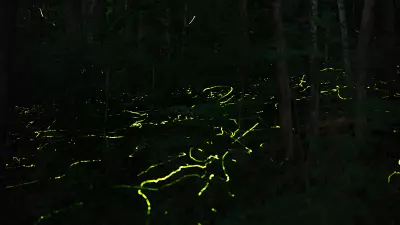Some experts contend that the diminishing ranks of fireflies is a harbinger of other mass extinctions and our own demise.

On a recent warm night, a group of people picked their way through the nearly pitch dark woods at Bernheim Forest and Arboretum.
They were there to see fireflies, also known as lightning bugs, and the insects did not disappoint.
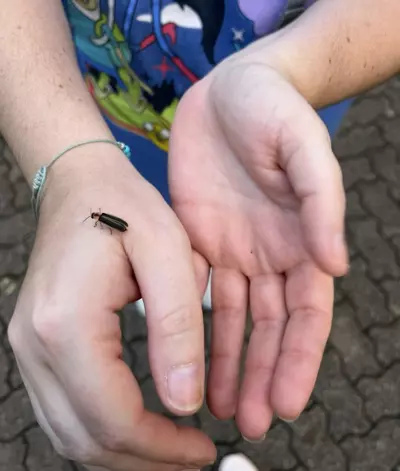
At least 15 species of firefly are known to be in Kentucky. (Kentucky Lantern photo by Morgan Eads)
At one point, one of the volunteer guides caught an interesting looking individual in his net and held it aloft for the crowd of 30 or so firefly hikers to see. They peppered him with questions.
One asked why the firefly was blinking so furiously.
“Desperation,” the guide said.
This firefly was quickly released to rejoin the dazzling light show among the trees, but over the last few years there’s been increasing concern about a decline in the iconic insect that is a staple of summers in Kentucky and beyond.
Recent viral social media posts claiming that current generations might be the last to see fireflies have stirred nostalgia and, in some commenters, their own resigned desperation.
Is it really too late to save the firefly?
Those who research and follow the populations in Kentucky say no. Still, evidence of a decline is there, and rarer firefly species are especially at risk.
“How many species do you want to lose?”
Information on the severity of the overall decline is hard to come by, and experts say that’s due to a lack of data. Data on the rarest strains of the about 2,400 firefly species in the world is even more elusive.
Darin McNeil, an assistant professor of wildlife ecology and management at the University of Kentucky, participated in a study released last year that endeavored to draw conclusions based on the limited anecdotal data that is available.
The study found a number of threats could be linked to shrinking firefly numbers, including impervious ground cover like sidewalks, roads and buildings.
But McNeil said the larger than expected impact of weather and climate on the populations of fireflies in any given location was of particular interest.
“We have to generalize a bit here because we don’t have data on individual species of fireflies,” McNeil said. “So fireflies in the eastern United States as a broad group, seem to really like cool, moist places.”
If an area sees changes in overall weather patterns, it could see a decrease or increase in common fireflies depending on the temperature and moisture, McNeil said.
But not all firefly species might be able to move and adapt.
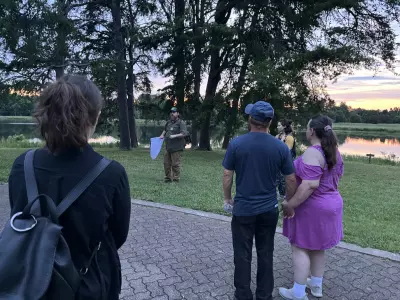
Attendees listen during Bernheim Forest’s last Firefly Friday of 2025. The events are held from late spring through early summer, the best time to see fireflies. (Kentucky Lantern photo by Morgan Eads)
While it doesn’t seem that most common firefly species are in danger of completely disappearing anytime soon, there are a number of more rare species that are at risk. They’re species that the general public might not ever notice being gone, and it’s likely there wouldn’t be a significant ecological impact in losing them, McNeil said.
“But the thing is, how many species do you want to lose?” McNeil said. “And at a certain point you’re going to start losing so many species that the ecosystem will eventually collapse.”
The disappearance of one rare firefly species could be an indicator of conditions that could lead to other species going extinct.
“So I would argue that while, yeah, probably the ecosystem can function without the blue ghost firefly, it serves as a canary in the coal mine for broader ecological issues,” McNeil said.
The blue ghost firefly, a rare species known to be primarily in Southern Appalachia, was spotted at the recent Firefly Friday event at Bernheim. Behind the scenes, researchers at the privately owned forest are taking a closer look at the peculiar insect.
The blue ghost
The fireflies most Kentuckians are likely familiar with are known for their rapidly blinking yellow-tone glow.
The blue ghost firefly has a comparatively dim blue glow that is constant for up to 60 seconds at a time. The males also only fly about a foot off the ground.
The females can’t fly at all, which combines with the species’ low numbers to make them especially vulnerable to threats.
“They’re stuck on the ground, so when companies come through and they clear the land of trees to build apartments or business, you know, offices, whatever that they’re working on, they’re destroying that land and those fireflies are incapable of just moving to a new patch of forest because they can’t move that quickly,” said Kathleen Kerr, a volunteer naturalist at Bernheim who helped lead the recent hike.
At least 15 species of firefly are known to be in Kentucky, and 13 of those can be found at Bernheim in Bullitt County about 25 miles south of Louisville.
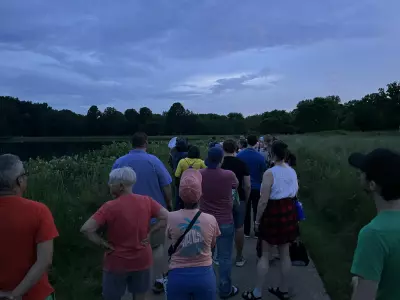
Hitting the firefly trail in Berheim Forest. (Kentucky Lantern photo by Morgan Eads)
Kelly Vowels, research coordinator for Bernheim Forest and Arboretum, is heading up a collaboration between Bernheim and a lab at the University of Georgia. Two grad students there are looking into two groups of fireflies — one being the rare blue ghost.
The aim of the research is to use genetics to determine the relationship between blue ghost fireflies across their range in the southeastern United States.
A deeper understanding of the species will help with conservation efforts, Vowels said.
Bernheim’s Firefly Friday events hope to bring some of that deeper understanding to the general public.
“When you see something in person and you learn to love it and care about it, you’ll take care of it and protect it in the future,” said Lynette Cox, director of marketing and communications at Bernheim.
“Feels like magic”
Bernheim’s firefly hikes take place on Friday nights during the best season to see fireflies – late spring into early summer.
“One of the most important things about these events is that it allows people to engage in what feels like magic,” said Jonathan Shirley, one of Bernheim’s volunteer naturalists. “These fireflies, they tie so deeply to our childhood for most of us.”
The fireflies combined with the song of the whippoorwill and the dark skies free of artificial light allow people to “experience something that you might not have access to anymore at your home,” Shirley said.
Shirley and the other volunteers enthusiastically led the recent group, the last of the season, lit only occasionally by the less-intrusive glow of red lanterns. The hikers included a wide range of ages, including one child who on multiple occasions exclaimed how cute the fireflies were.
Whitney Nowicke of Louisville surprised her mom with a trip to Bernheim for a firefly hike. She’d seen the social media posts online claiming that fireflies will disappear.
“While I think there is some truth to that, I think how everything is online, it’s overly sensationalized to make people be like, ‘oh my god, that’s so sad,’” Nowicke said. “And then, you know, when they’re sitting around having a conversation at a bar or whatever, it’s just a talking point for them, but then they don’t really do anything about it.”
Nowicke said programs like the hike at Bernheim showed that there’s still work that can be done to save fireflies.
Citizen science and backyard conservation
At the end of the hike, the volunteers gathered the group on a bridge. In the red lantern light, they spoke over the calls of numerous frogs to tell the group about ways they can help preserve fireflies and other species in their own backyards.
To simplify, Shirley said they could do the most for native species by doing less. Less manicuring of lawns, less nighttime illumination.
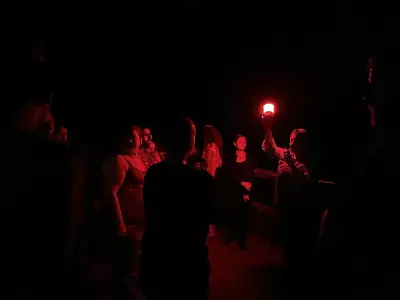
A firefly walk at Berheim Forest, the last of the season, is lit only occasionally by the less-intrusive glow of red lanterns. (Kentucky Lantern photo by Morgan Eads)
In a separate interview, McNeil said that people can also help with the lack of data that has made tracking firefly populations so difficult. The study he participated in at UK relied entirely on data from a project called Firefly Watch, which gathered information through citizen science.
The Firefly Watch project has since changed hands from Mass Audubon to the Xerces Society, but people can still contribute by providing data.
“You can sign up tonight and submit data from your backyard, or mom’s house or some park up the street, wherever you want, even downtown, and upload data on how many fireflies you’re seeing and some characteristics of that site at the time you’re visiting,” McNeil said. “Even if you see zero, that’s very valuable data.”
McNeil said it’s also a great way to get kids involved and thinking about science.
Raking leaf litter to the side of your yard instead of getting rid of it is another way to help fireflies, McNeil said.
Before fireflies become the flying light-bringers we’re familiar with, they spend up to two or three years in a state that looks quite different. And while they’re in that larval state, they need cover like leaf litter to survive.
“Tiny little Bengal tigers”
Fireflies have a long lifespan compared to a lot of insects, and only a few weeks of that lifespan are spent flying around and searching for a mate.
After hatching, the firefly will spend up to a few years as a wingless larva that McNeil compared to an “armored grub.”
And that armored grub is a tiny vicious predator that uses its ability to inject its digestive enzymes to eat things much bigger than itself, including snails and slugs.
Fireflies put on a light show at Bernheim Forest, June 17, 2022. (Photo by Eric Nally)
“They’re tiny little Bengal tigers,” McNeil said.
While vicious, fireflies are most vulnerable in that larval state.
So, in instances of singular extreme weather events — like drought, heat waves or flooding — or an overall climate shift or habitat disruption, any change in the number of fireflies we see lighting the night sky might be delayed by a year or two, McNeil said.
While not as obvious as they are once they start flying, the firefly larvae can still be spotted by observers. McNeil recommends going to a dark park or natural area around April with no flashlight or light source. Once your eyes adjust to the darkness, you can often see the constant glow of the tiny larvae on the ground.
“These animals, they have the ability to glow that is ingrained in every fiber of their being,” McNeil said.
For now, information on the populations of fireflies remains sparse. Efforts to track them are made more difficult by the fickle nature of the insect, Vowels said.
“Some nights, they’re all out, and other nights you might miss them, and sometimes they’re early and sometimes they’re late,” Vowels said. “So they’re extremely difficult.”
Still, the efforts will continue.
“I think now, more than ever, is the time to begin monitoring fireflies so that if there are declines, they’re noticed,” McNeil said.

